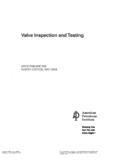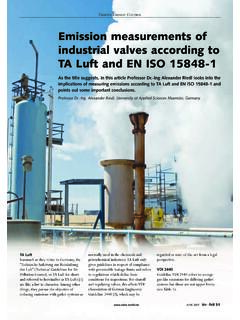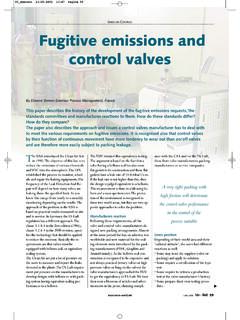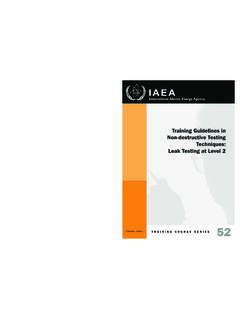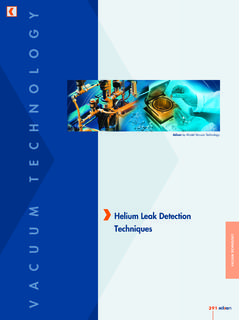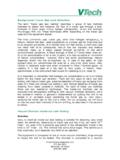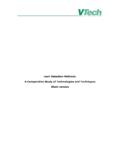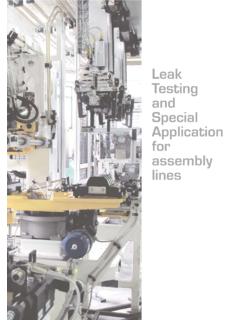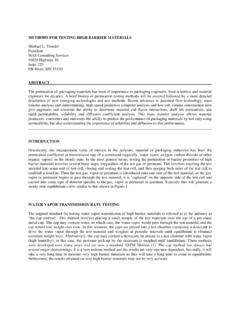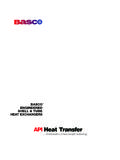Transcription of Effective solutions to beat Fugitive Emission - …
1 Keywords: FE Oil & Gas testing Effective solutions to beat Fugitive EmissionThe industry is seeing an increasing trend in the demand for stricter Emission control norms mandated by international, national and local organizations all over the world. Hence a thorough understanding of the Fugitive Emission subject is becoming extremely important. Fugitive Emission is unintended or irregular release of pollutants, hazardous fl uids, gases or vapors into the environment, through any static or dynamic joints of pressurized equipment such as pressure vessels, pipelines, valves etc.
2 And not from usual sources such as chimneys, stacks and of Benzene from oil refi neries & chemical plants cause a long term health risk to workers and local communities or the release of Hydrogen Sulfi de (H2S), often referred as sewer gas at various concentrations have following effects on humans as: 10 ppm = Eye irritation 100 ppm = Coughing, loss of smellabove 15 min of exposure 500~700 ppm = Loss ofconsciousness leading to fatality 800 ppm = Rapid loss ofconsciousness, severely affectingrespiration causing deathAnother example is emissions of Sulphur Dioxide to the atmosphere, & if reacts with the water vapor enhances acidity.
3 This results in the acidifi cation of receiving waters and consequent damage to ecosystems, especially lakes and forests which inturn has adverse effect on human healthWhy Fugitive Emission testing (FET)?1. To check performance level ofOn-Off & Control valves with regards to To minimize and control leaks atprocess facilities & carry out regular leak detection and repair activities. 3. Routine inspections, using appropriatetechniques can be used to identify leaks and estimate leak rate in order to decide on appropriate corrective Techniques, Standards, and Codes:Various international standards and codes are available for selecting the Fugitive Emission testing methodology and acceptance criteria.
4 It is therefore the responsibility of end user to select appropriate code for an intended application under the guidelines of local/national statutory body. Frequently used standards/codes are:1) ASME Section V, Article 10:a) Appendix IV: - Detector ) Appendix V: - Tracer Probe ) Appendix IX: - Hood ) I SO 15848-1: Procedure for FugitiveEmission Classifi cation System andQualifi cation Procedures for TypeTesting Of ) ISO 15848-2: Procedure for FugitiveEmission- Production Acceptance Testof ) ANSI/ISA : Standard Method for Evaluationof External Leakage of Manual &Automated On-Off ) API 622, 23 rd edition: Oct.
5 2011: TypeTesting of Process Valve Packing for(Downstream Segment) of the frequently used standards by the industry is ISO 15848-1:2006. Excerpts from ISO-15848-1-2006: a) Scope: Limited for application in volatile airpollutants and hazardous fl uids. Use to detect external leakage ofValve Stems and Body joint(s). Valve selection from standardproduction at ) Type Test Conditions: The valve has been tested andaccepted as per ISO 5208 or anyapplicable standard prior to FET. Application of any protective coatingis not permitted prior to test.
6 Valve shall be clean & dry & ifrequired, stem packing may bechanged before ) Test Fluid & Parameters: Test fl uid = Helium gas (97%minimum purity by volume). Test pressure = Rated pressure attest temperature given shellmaterial in relevant Narayan Patil, Virgo Valves & Controls Ltd. 2013 1 Emission CONTROLW ould you like to receive a hardcopy of this magazine's full publication? Please include the month and year of publication and contact Mrs. Erica Riethorst at Test temperature = Mechanical cycling at both room temperature and at selected test ) Valve Performance Criteria:The valve performance criterion is based on combination of following: A) Tightness class, B) Endurance class, and C) Temperature Tightness ClassIt defi nes allowable leakage.
7 However, leakage values are calculated considering Helium as test fl uid. Above Tightness Class is defi ned for Only Valve Stem sealing system, and allowable leakage from body seals: 50 ppmv. Three types of tightness class are: Tightness Class A: Allowable leakage rate = x 10^-8 atm. cc/sec/mm stem dia. Tightness Class B: Allowable leakage rate = x 10^-6 atm. cc/sec/mm stem dia. Tightness Class C: Allowable leakage rate = x 10^-4 atm. cc/sec/mm stem Endurance ClassIt is based on Number of Mechanical Cycles (Close-Open-Close).
8 The Three types of endurance class for Isolation Valves are as follows: C01: Minimum required 500 Mechanical cycles with two thermal cycles. C02: Addition to CO1 of 1000 Mechanical cycles with one D Guidelines for achieving Tightness Class Tightness Class A typically with bellow seals or equivalent stem (shaft) sealing system for quarter turn valves (measured only with helium using vacuum method). Tightness Class B with PTFE based packings or elastomeric Seals. Tightness Class C with Flexible Graphite based packings. FET challenges as per ISO 15848 During FET, the valve needs to pass through required mechanical cycles under different temperature range depending on application.
9 Temperature range can be anywhere between (-) 196 deg. C to 400 deg. C. For applications where temperature is between (-) 196 deg. C to 200 deg. C, FET with stringent acceptance criteria is relatively easier to achieve as there are different seal materials available in Elastomers and Plastomers which can be used as primary seal(s) in addition to graphite seal(s). FET becomes more critical for high temperature service applications (temp > 200 deg. C) because of the limited choices available for sealing materials like graphite and/or special metallic seals.
10 Also in many cases, because of various factors governing a specifi c thermal cycle 1500 no. of total mechanical cycles having three thermal cycles. C03: Addition to CO2 of 1000 Mechanical cycles with one thermal cycle 2500 no. of total mechanical cycles having four thermal Temperature ClassPrimarily fi ve classes are defi ned as below (alternative temperature classes shall be subject to agreement between purchaser & manufacturer):(t-196 C)(t-46 C)(tRT)(t200 C)(t400 C)-196 C-46 CRoom temperature, C200 C400 C June 2013 Emission CONTROLA bout the authorMr.
